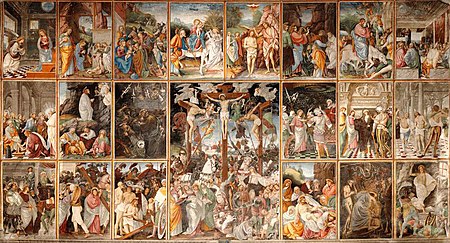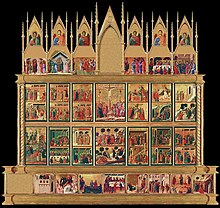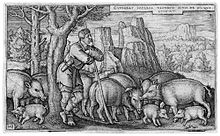Life of Christ in art
[1] From the Renaissance, and in Protestant art, the number of subjects increased considerably, but cycles in painting became rarer, though they remained common in prints and especially book illustrations.
The group in art are: Annunciation, Nativity, Presentation, Baptism, Raising of Lazarus, Transfiguration, Entry into Jerusalem, Crucifixion of Jesus, Harrowing of Hell, Ascension, Pentecost, Dormition of the Theotokos (Death of the Virgin).
[3] After the Early Christian period, the selection of scenes to illustrate was led by the occasions celebrated as Feasts of the Church, and those mentioned in the Nicene Creed, both of which were given prominence by the devotional writers on whose works many cycles appear to be based.
Another influence, especially in smaller churches, was liturgical drama, and no doubt also those scenes which lent themselves to a readily identifiable image tended to be preferred.
An exception is St Mark's Basilica in Venice where a 12th-century cycle of mosaics originally had 29 scenes of the miracles (now 27), probably derived from a Greek gospel book.
Emile Mâle's famous study of 13th-century French cathedral art analyses many cycles, and discusses the lack of emphasis on the "public life [which] is dismissed in four scenes, the Baptism, the Marriage at Cana, the Temptation and the Transfiguration, which moreover it is rare to find all together".
Scenes with miracles were more often found in cycles of the life of Saint Peter and other apostles, from late antique sarcophagi[12] to the Raphael Cartoons.
Such schemes were later called the Poor Man's Bible (and in book form the Biblia Pauperum) by art historians, and were very common, though most have now vanished.
In Protestant areas production of paintings of the Life stopped very soon after the Reformation, but prints and book illustrations were acceptable, as free from the suspicion of idolatry.
Of the thirty or so parables of Jesus in the canonical Gospels, four were shown in medieval art almost to the exclusion of the others, but not normally mixed in with the narrative scenes of the Life, though the page from the Eadwine Psalter (Canterbury, mid 12th century) illustrated here provides an exception to this.
From the Renaissance the numbers shown widened slightly, and the three main scenes of the Prodigal Son – the high living, herding the pigs, and the return – became the clear favourites.










